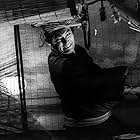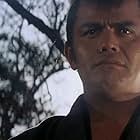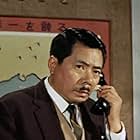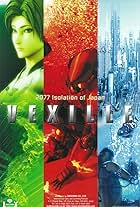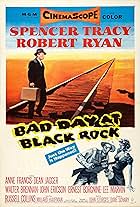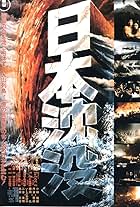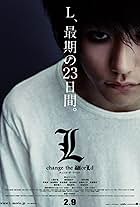Japan and Russia clash in what comes to be known as the Russo-Japanese War. An attempt by the Japanese fleet and army to take Port Arthur fails, and a Russian fleet bears down on the Sea of ... Read allJapan and Russia clash in what comes to be known as the Russo-Japanese War. An attempt by the Japanese fleet and army to take Port Arthur fails, and a Russian fleet bears down on the Sea of Japan.Japan and Russia clash in what comes to be known as the Russo-Japanese War. An attempt by the Japanese fleet and army to take Port Arthur fails, and a Russian fleet bears down on the Sea of Japan.
Ryûtarô Tatsumi
- General Gonbei Yamamoto
- (as Ryutaro Tatsumi)
Hakuô Matsumoto
- The Emperor
- (as Kôshirô Matsumoto)
- Director
- Writer
- All cast & crew
- Production, box office & more at IMDbPro
Featured reviews
Much like THE LAST VALLEY is the only real (known to me anyway) film to deal with the '30 Years War', this film is the only one (that I know of) to cover the 'Russo-Japanese War'. It's interesting as this piece of history isn't really covered much. At the turn of the century there was a lot of feuding between the European powers, especially over their empires in China, the Middle East, and Africa. It was the era when new weapons were constantly being introduced and when newly industrialized nations (like Japan) were building their military machines and new ships to rule the seas. This unique era provided armies the opportunity to slaughter each other with modern weapons like artillery and magazine-loading guns, without the benefit of tanks or airplanes (which to me makes war a lot less interesting and with one side or the other with an unfair overwhelming advantage).
This movie excellently brings such combat to life, and (unlike LAST VALLEY which was a small slice of life) covers the full breadth of the conflict... culminating in the huge and decisive battle in the Tsushima Straights between the fledgling Japanese force and the mighty 40-ship Russian Baltic Fleet which had sailed around the world for 6 months to fight them.
This film was the final penultimate film for Japanese special effects director Eiji Tsuburaya, who provides some of his best, most detailed, and most convincing miniature work ever. There's a healthy number of composite shots to blend the miniatures with the live action, and the effects are overall quite amazing (though not completely convincing). The acting (especially with American expatriates as Russians) leaves some to be desired, but one has to give the Japanese credit for improvising since Russia angrily refused to cooperate with this production at all.
The land battles during the siege of Port Arthur are quite large and exciting, even genuinely moving in a few places as you can really feel General Nogi's frustration with the extremely high casualties and lack of progress. Mifune brings a great gravitas to his role as Togo, dubbed "Japan's Nelson" at the time, and several of the better character actors from the early Godzilla movies pop up as random officers. The ending features a similar speech to Christopher Plummer's in the following year's WATERLOO, which gives all the fun, excitement, and jingoism a more somber spin.
I must also mention the excellent cinematography, staging, and music which give the film a very polished look of a monumental, groundbreaking epic. More so than most other war films of the time. Sure this film takes a few Historical liberties (mostly to simplify the more complex battles) but it still provides a lot of eye-opening insight on a largely forgotten, but significant war (in that it set the stage for the Russian Revolution AND the second Sino-Japanese war).
All in all, I was not disappointed. For a Japanese war movie, it's the best I've seen, right up there with the sadly rare STORM OVER THE PACIFIC.
This movie excellently brings such combat to life, and (unlike LAST VALLEY which was a small slice of life) covers the full breadth of the conflict... culminating in the huge and decisive battle in the Tsushima Straights between the fledgling Japanese force and the mighty 40-ship Russian Baltic Fleet which had sailed around the world for 6 months to fight them.
This film was the final penultimate film for Japanese special effects director Eiji Tsuburaya, who provides some of his best, most detailed, and most convincing miniature work ever. There's a healthy number of composite shots to blend the miniatures with the live action, and the effects are overall quite amazing (though not completely convincing). The acting (especially with American expatriates as Russians) leaves some to be desired, but one has to give the Japanese credit for improvising since Russia angrily refused to cooperate with this production at all.
The land battles during the siege of Port Arthur are quite large and exciting, even genuinely moving in a few places as you can really feel General Nogi's frustration with the extremely high casualties and lack of progress. Mifune brings a great gravitas to his role as Togo, dubbed "Japan's Nelson" at the time, and several of the better character actors from the early Godzilla movies pop up as random officers. The ending features a similar speech to Christopher Plummer's in the following year's WATERLOO, which gives all the fun, excitement, and jingoism a more somber spin.
I must also mention the excellent cinematography, staging, and music which give the film a very polished look of a monumental, groundbreaking epic. More so than most other war films of the time. Sure this film takes a few Historical liberties (mostly to simplify the more complex battles) but it still provides a lot of eye-opening insight on a largely forgotten, but significant war (in that it set the stage for the Russian Revolution AND the second Sino-Japanese war).
All in all, I was not disappointed. For a Japanese war movie, it's the best I've seen, right up there with the sadly rare STORM OVER THE PACIFIC.
The Russo-Japanese War (1904-1905) is an interesting subject for a variety of reasons. In terms of naval history, it was a game-changer, a period of transition that saw the modernization of the battle equipment, and worked as a prelude for World War I. In terms of the end result it was also interesting, as the underdog Japan won it, causing widespread rebellion within the Russian Empire. Since the Japanese of the 1960's could not really make films that glorified their country's more recent military history, it was logical for them to return to the days of Togo Heihachiro, the country's great naval hero.
Maruyama Seiji directed a number of war films during his career, and by 1969 he had also directed some that included Mifune Toshiro, who leads an all-star cast as Togo. Like many Japanese war films, including "Japan's Longest Day" (Nihon no ichiban nagai hi, 1967), this film tries to paint a half-documentary assessment of the events in the war, by featuring a variety of characters in different locations, and a narrator to explain away the rest. Whereas the solution worked for that picture, it becomes an annoyance in this one. The narrator is present far too often, and the film fails to follow the classic rule of "show, don't tell". This film tells you, and through that it may put you to sleep. The changing location and different characters did help to see the bigger picture of the war, but also affected the character development. There isn't any. These characters aren't deep, they are cardboard-copies of historical persons, who are treated respectfully, but not portrayed as interesting individuals. Then again individualism wasn't really Japan's thing at the time.
This film is informative, and the contextualization is thorough. Yet the way its told is also a bit too nationalistic for my blood. Japan is told to have started the war, because Russia tightened their grip on Manchuria, but Japan's own colonial interests are left unmentioned. Also whereas the Japanese films about World War II are nearly always anti-war, you can hardly say the same about this, though people are shown to die.
Though the historical subject fascinates me, I found this film to be a bore. I love the actors, but not one of them is bringing their A-game to this production. Mifune is one-sided as Togo, Nakadai's adventures in the Swedish embassy felt like filler, it's not right to have the peaceful Ryu Chishu as a military officer, and many of the less famous actors had very little character traits. All in all, I would read a good historical book instead.
Maruyama Seiji directed a number of war films during his career, and by 1969 he had also directed some that included Mifune Toshiro, who leads an all-star cast as Togo. Like many Japanese war films, including "Japan's Longest Day" (Nihon no ichiban nagai hi, 1967), this film tries to paint a half-documentary assessment of the events in the war, by featuring a variety of characters in different locations, and a narrator to explain away the rest. Whereas the solution worked for that picture, it becomes an annoyance in this one. The narrator is present far too often, and the film fails to follow the classic rule of "show, don't tell". This film tells you, and through that it may put you to sleep. The changing location and different characters did help to see the bigger picture of the war, but also affected the character development. There isn't any. These characters aren't deep, they are cardboard-copies of historical persons, who are treated respectfully, but not portrayed as interesting individuals. Then again individualism wasn't really Japan's thing at the time.
This film is informative, and the contextualization is thorough. Yet the way its told is also a bit too nationalistic for my blood. Japan is told to have started the war, because Russia tightened their grip on Manchuria, but Japan's own colonial interests are left unmentioned. Also whereas the Japanese films about World War II are nearly always anti-war, you can hardly say the same about this, though people are shown to die.
Though the historical subject fascinates me, I found this film to be a bore. I love the actors, but not one of them is bringing their A-game to this production. Mifune is one-sided as Togo, Nakadai's adventures in the Swedish embassy felt like filler, it's not right to have the peaceful Ryu Chishu as a military officer, and many of the less famous actors had very little character traits. All in all, I would read a good historical book instead.
First, I like this movie. The battle scenes are generally well done and the model work is very impressive. It is not entirely true to the actual events but how many war movies are? The acting is not great, except for Mifune, but it's not unwatchable either. And, as another reviewer mentioned, it is the only movie I know of that covers the Russo-Japanese War.
As one of the reviewers here commented, the movie subtitles are notably bad, so much so that there is a statement at the end of the movie apologizing for the misspelled Russian names and incorrect ranks. But it wasn't just the Russian ranks that were wrong, they were incorrect for most of the Japanese characters, too, and the whole translation was not good English. The subtitles were bad enough that they distracted me from the story. In some movies, bad subtitles can be enjoyed as humor, but this is not the kind of movie where that should happen. It bothered me enough that I decided to see if I could do something about it.
I don't speak Japanese so I took the existing translation and fixed the obvious problems of spelling, grammar and syntax. Poor use of idiom could usually be determined from context. And there were lots of errors or inconsistencies in translation of military ranks and Russian ship and personnel names. Some of it is differences in culture, however. For example, the "san" suffix on Japanese names is normally translated as "Mr." but that isn't really how western culture handles it. The Japanese are more formal than we so in most instances we would just leave off the "Mr." and call someone by their name. But in the case where the person has a title or rank, we would use that. For example, instead of "Mr. Ito" or "Mr. Togo" we would say "Prince Ito" or "Admiral Togo." The other thing was place names. The original subtitles used Japanese place names which are mostly meaningless to us, for example "Ryojun" instead of "Port Arthur." And then there were just the mistakes of words that look similar but mean very different things. There is a line that was translated as "I am doing my dumbest to insure victory" when, of course, it should be "I am doing my damnedest to insure victory." Finally, I took some liberty and made the narration of some of the battles more accurately reflect the actual historical events. For example, the movie has Togo "crossing the T" in the Battle of the Yellow Sea when actually he used that tactic (twice) in the Battle of Tsushima.
For anyone interested, I have posted the revised subtitles to several of the more useful subtitle sites on the web.
UPDATE: It seems there are at least two other movies about the Russo-Japanese War. Not surprisingly, both are also Japanese made.
As one of the reviewers here commented, the movie subtitles are notably bad, so much so that there is a statement at the end of the movie apologizing for the misspelled Russian names and incorrect ranks. But it wasn't just the Russian ranks that were wrong, they were incorrect for most of the Japanese characters, too, and the whole translation was not good English. The subtitles were bad enough that they distracted me from the story. In some movies, bad subtitles can be enjoyed as humor, but this is not the kind of movie where that should happen. It bothered me enough that I decided to see if I could do something about it.
I don't speak Japanese so I took the existing translation and fixed the obvious problems of spelling, grammar and syntax. Poor use of idiom could usually be determined from context. And there were lots of errors or inconsistencies in translation of military ranks and Russian ship and personnel names. Some of it is differences in culture, however. For example, the "san" suffix on Japanese names is normally translated as "Mr." but that isn't really how western culture handles it. The Japanese are more formal than we so in most instances we would just leave off the "Mr." and call someone by their name. But in the case where the person has a title or rank, we would use that. For example, instead of "Mr. Ito" or "Mr. Togo" we would say "Prince Ito" or "Admiral Togo." The other thing was place names. The original subtitles used Japanese place names which are mostly meaningless to us, for example "Ryojun" instead of "Port Arthur." And then there were just the mistakes of words that look similar but mean very different things. There is a line that was translated as "I am doing my dumbest to insure victory" when, of course, it should be "I am doing my damnedest to insure victory." Finally, I took some liberty and made the narration of some of the battles more accurately reflect the actual historical events. For example, the movie has Togo "crossing the T" in the Battle of the Yellow Sea when actually he used that tactic (twice) in the Battle of Tsushima.
For anyone interested, I have posted the revised subtitles to several of the more useful subtitle sites on the web.
UPDATE: It seems there are at least two other movies about the Russo-Japanese War. Not surprisingly, both are also Japanese made.
i was a young us forces member, working part time in the movies during 1967-70 in japan. in this movie, i was an aid-de-camp to the russian admiral (rodyshvinski). as i was an american, not speaking russian, they brought a professor from waseda univ to teach me phonetic russian, not having any idea what i was saying. 30+ years later, here i am in kiev for 10 years and want to find a copy of this movie to see what i said as i died dramatically, having been shot putting up the flag as our ship was sinking... it was said to be a significant movie from the japanese standpoint at the time, but i'm finding the russians i work with have a totally different perspective ;-) i'd also like cast member credits. i see our agent, mr yusef a. is listed.
Did you know
- TriviaThis was special effects director Eiji Tsuburaya's final film.
- GoofsDuring a tracking shot across the crew of the Mikhasa as they fire their cannons out at the Russian fleet while the ship desperately maneuvers to avoid the barrage, a stationary striped pole can be seen sticking out of the water through one of the portholes.
- SoundtracksSen Yuu
Traditional Japanese Military Song
Performed by Male Chorus
Public Domain
Details
- Release date
- Country of origin
- Language
- Also known as
- Bitka za Port Artur
- Production company
- See more company credits at IMDbPro
- Runtime2 hours 8 minutes
- Sound mix
- Aspect ratio
- 2.35 : 1
Contribute to this page
Suggest an edit or add missing content

Top Gap
By what name was Battle of the Japan Sea (1969) officially released in India in English?
Answer



